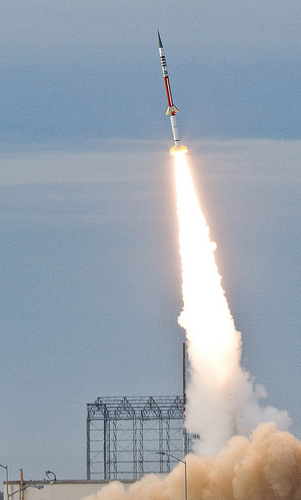By Jessica Wind (The Cascade) – Email
Print Edition: March 6, 2013
What better way to understand rockets than to build one yourself?
This is the question students Wade Labelle and Orrin Malacko asked themselves before setting out to construct their own rocket.
Labelle is a former UFV physics major who recently transferred to SFU to finish his program and Malacko is a third-year engineering student at UFV. Together, they are putting their skills and passion for rockets into the project.
“Who doesn’t want to build a rocket?” Malacko asked. “Rockets are just cool.”
The students got in touch with former NASA scientist Dr. Joseph Resnick to learn how to build their rocket. He sent them a paper with the necessary formulas and equations. Although it was helpful, they decided that an experiment would give them their answers faster.
“We’re going to put it in the back of [Malacko’s] truck and test the aerodynamics that way,” said Labelle.
Malacko described the science of the hyperfuel engine that will go into the rocket.
“You have your little metal tube, reaction chamber, and you have your fuel … in our case we’re using RP1 rocket fuel,” he explained. “It burns and you enter your oxidizer and that’s what makes the—.”
Here Malacko stopped his explanation to make an enthusiastic explosion sound.
The finished product is expected to be almost three feet tall with a fuel chamber of about 14 inches. They could calculate the projected height prior to launch, but again, they are more excited to simply test it out.
“You have to solve a differential equation, a variable mass problem. Which we did in Physics 221, but then what we didn’t do is add on drag,” explained Malacko.
Instead, they plan on strapping a Go-Pro camera to the rocket to film the height of the launch.
Building rockets is not a free enterprise; the canister of nitrous oxide that they plan to use for their oxidizing agent could cost them over $300.
Labelle appealed to SFU after hearing that they had funded student projects in the past.
“I sent out an email today, made it all formal and nice, hoping they’d give us some funding,” he said.
Malacko is also planning on seeking assistance from UBC to test the rate of the rocket’s exhaust velocity, something that generally costs money to accomplish.
Projects of this magnitude are not uncommon among engineering students, but Malacko explained that most people avoid building rockets.
“A rocket is typically not done because it might blow up and people frown upon you exploding things in your back yard,” he said.
The launch won’t be in one of their backyards. They hope to negotiate with a Chilliwack farmer in order to conform to standard safety regulations for rocket launches.
“What you actually need, when you exceed 3000 feet, which I sure hope we exceed, you need a three kilometre radius of nothing,” explained Malacko.
The project isn’t for school, but that’s not why they’re building the rocket. The hands-on experience is invaluable for their hopeful careers in rocket science.
“That’s the dream; [to be] a rocket scientist at NASA hopefully,” said Labelle, who is looking forward to putting rocket building as a hobby on his resume.
At this point there is no set date for the launch. They plan to work on it for as long as it takes.
Malacko explained his one goal for the finished product.
“Hopefully it goes up. That’s a good goal. I want it to go straight up and not off somewhere. The best rocket scientist of all time, Wernher von Braun, when he made the V2 rocket for Nazi Germany he failed a lot. He’s a pretty smart guy, so I don’t know what that means for us,” he laughed.


